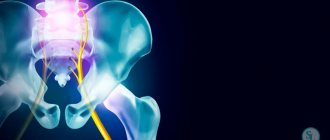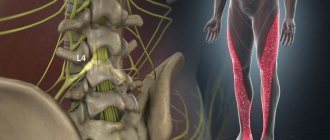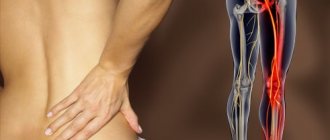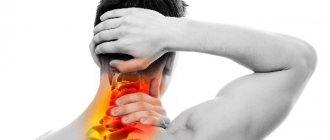Causes of pinched sciatic nerve
The nature of the development of pathology and clinical manifestations are very diverse. The most common cause of the disease is compression of nerve fibers in the structure of the spine. Pressure on the nerve roots sometimes leads to their inflammation, accompanied by severe pain. Symptoms manifest themselves differently, depending on the location of the pathological process.
- When one of the roots of the sacral nerve plexuses is compressed by a hernial protrusion, the symptoms manifest as sharp pain, intense when coughing and movement. On the first day, signs of impaired skin sensitivity and muscle weakness appear.
- A root pinched by a dense ligament or bone growths, displacement of discs or narrowing of the spinal canal caused by osteochondrosis causes gradually increasing pain and signs of complete or partial paresthesia. Muscle weakness appears later, and if the process is advanced, muscle atrophy cannot be ruled out.
- Compression of the sciatic nerve by muscles (called tunnel syndrome) can be a consequence of articular pathologies, spinal diseases, injuries, flat feet, and unsuccessful injections in the buttock. It manifests itself as pain in the buttock, burning pain in the sole area, loss of control of the functions of the foot.
- Cut and puncture wounds, injuries and bruises of the sciatic nerve are accompanied by moderate pain. By blocking impulse transmission, they can provoke muscle atrophy, the development of paralysis, dry skin and ulcers on the legs.
Kazieva Aminat Ziyavovna
Neurologist
Rostov State Medical University
Experience since 2012
A kind of trigger for the development of pain can be:
- the influence of unusual physical activity in patients with a tendency to physical inactivity;
- prolonged stay in a forced position at work;
- vibration or power loads;
- body hypothermia;
- infectious pathologies.
The greatest vulnerability to the development of sciatica is observed in middle-aged and elderly patients. Aging of the body leads to degenerative changes in the intervertebral discs. They become coarser, gradually lose moisture, elasticity and height, which leads to compression of the nerve roots and the development of acute pain.
Causes of lumbodynia
Low back pain (lumbodynia), both chronic and acute, is most often caused by pathological processes (degenerative-dystrophic) in the spine, especially in the lumbar region. In addition to osteochondrosis, lumbodynia is caused by its complications, such as protrusion, spondylolisthesis, intervertebral hernia, spondyloarthrosis, spondylosis.
The mechanism of lumbodynia is based on irritation of the nerves (especially sinuvertebral). Pain is especially pronounced with cracks in the fibrous ring. Also the cause is abnormalities in the development of the lumbar spine.
Pain can occur after a single physical overload, lower back injuries, hypothermia, stress, sudden turns of the body, hypothermia, exposure to drafts, prolonged exposure to an uncomfortable or monotonous position. Moreover, lumbodynia can manifest itself not only after a few days or weeks, but even several months after the provoking factor.
The risk group also includes those who are overweight, have certain chronic diseases, have infectious diseases, workers in hazardous industries, those who experience increased stress, lead an adynamic lifestyle, or are in an uncomfortable or the same body position for a long time.
Diagnosis for pain in the gluteal region
To identify the causes of pain and make a diagnosis, a physical examination by a neurologist is necessary. As objective methods of diagnostic search, in medical in Rostov-on-Don, high-precision modern equipment is used, which allows you to quickly determine the cause of pathological processes.
1) Using computed tomography, not only the structure of the bones, but also the vertebral discs are examined in detail. A tomograph is indispensable in diagnosing hernial protrusions, tumor formations and damage caused by trauma.
2) Magnetic resonance imaging examination allows us to identify the nature and extent of damage to the sciatic nerve plexuses and the features of the processes occurring in them.
The price for instrumental diagnostics is affordable. It includes the examination itself, its result on disk, and a transcript from the diagnostician.
Treatment with manual therapy
You can get rid of lumbodynia only by eliminating the causes that caused it. This type of treatment can be considered complete. In other cases, the help will have a temporary effect and after some time, lumbodynia will appear again, and if the treatment was inadequate, it will intensify or recur. It is important to find a good chiropractor, otherwise you may not only not be cured, but even make things worse.
Since the main cause of lumbodynia is considered to be vertebral osteochondrosis, the cause of which, in turn, is improper functioning of the spine, it is not lumbodynia that should be treated, but osteochondrosis. In addition, by getting rid of osteochondrosis, you will protect yourself from the occurrence of its complications, such as hernias and disc protrusions.
Manual therapy is considered one of the most effective ways to eliminate problems in the spine. It is especially effective in combination with the subsequent implementation of a complex of physical therapy (physical therapy). All this not only improves the condition, but also stimulates recovery processes, thanks to which the course of the disease can sometimes not only be stopped, but also reversed.
The number of procedures is prescribed individually, based on the patient’s health characteristics, stage of the process, complications, and concomitant diseases. It is also necessary to perform exercise therapy to consolidate the achieved result and maintain it after treatment.
In what cases is a sciatic nerve block prescribed?
A medication block for sciatic nerve pain is not a form of treatment for sciatica. Indications for the procedure are determined by the need for emergency blockade of severe pain caused by:
Kazieva Aminat Ziyavovna
Neurologist
Rostov State Medical University
Experience since 2012
- pronounced inflammatory process;
- development of local trophic disorders;
- constant aching pain along the affected nerve;
- physical overload of the ligamentous apparatus;
- muscle spasms and myogenic contracture.
The blockade is a highly effective procedure. It is indispensable when it is necessary to quickly eliminate swelling, relieve acute attacks of pain and in cases of severe clinical illness.
Symptoms of the disease
The most important symptoms of sciatic nerve sciatica are:
- pain localized in any part of the body along the passage of the nerve fiber: in the lower back, buttock, back of the thigh, lower leg, foot;
- loss of sensitivity, numbness of the lower limb along the nerve fiber;
- paresthesia - tingling sensations, “pins and needles” in the foot and toes.
The nature of the pain is most often shooting, but it can also be burning, dull, aching, etc. During periods of exacerbation, when moving the spine or leg, it can intensify and become unbearable. As a rule, the disease affects one limb, but sometimes pain appears in both legs at once. In the most severe cases, the disease leads to paralysis of the leg muscles, sometimes spreading to the pelvic muscles, causing urinary and fecal incontinence in the patient.
How is a sciatic nerve block performed?
Drug blockade for neuralgia is an emergency way to relieve pain when injections, tablets and physical therapy methods fail. A blockade of the sciatic nerve for pain is carried out by injecting individually selected drugs into the affected area. Administration of drugs can be perineural or periarticular (into nervous or periarticular tissues).
There are several ways to carry out a blockade for sciatica:
- lying on your stomach (Yasenetsky method);
- lateral access (lying on your back);
- lying on your side according to Moore's method;
- anterior approach - rarely performed. There is a high probability of damage to large vessels.
As an example, we will give a simple blockade technique using the Moore method.
Kazieva Aminat Ziyavovna
Neurologist
Rostov State Medical University
Experience since 2012
- The patient lies on his side, legs bent at the knees. The heel of the diseased limb is pressed tightly against the healthy leg.
- The doctor palpates the tubercle on the hip bone (trochanter) and draws a line from it to the iliac pelvic bone.
- A perpendicular line is drawn from the middle of the line to the coccyx.
- The point of drug administration is the end of the line.
- Within 1 minute, only up to 10% of the drug is administered.
- When the patient feels numbness, the needle is moved deeper without any pain and the remaining medication is injected.
If the blockade is carried out by an experienced doctor and all rules are followed, the procedure is safe. Complications are rare.
- If the medicine enters the vessel during administration, the patient may experience agitation, signs of dizziness and nausea, and tinnitus.
- If a needle damages a vessel, a bruise may remain.
- Failure to comply with the rules of antisepsis and asepsis is manifested by a suppurative process at the injection site.
- In the absence of allergy tests for the drug, allergic reactions may develop.
- Damage to a nerve by a needle causes the development of neurological disorders (impaired motor functions and sensitivity).
- The introduction of a large amount of the drug provokes compression of the nerve fibers, which will lead to even greater pain.
Before choosing a clinic and a doctor, take the time to read reviews from real patients and doctors.
Characteristic
The largest nerve in the body is formed outside the spinal canal (in the pelvic area). The nerve goes through the gluteal opening, is closed by the muscle, then goes down to the back of the thigh, moving to the lower leg.
In the popliteal region it is divided into the medial thick tibial branch and the fibular lateral branch. They pass along the leg, then approach the foot and hand (phalanxes).
It is thanks to the sciatic nerve that full mobility of the legs and the activity of the small pelvis are ensured.
When a problem such as sciatica appears, it is important to begin diagnosis and treatment as quickly as possible, otherwise you may end up with disability.
What drugs are used for blockade
To block acute attacks of pain during neuralgia, medications that have an analgesic and anti-inflammatory effect are used in medicine - novocaine blockade, lidocaine blockade and diprospan solution.
Novocaine blockade of the sciatic nerve has:
- bacteriostatic, antiseptic and antiallergic properties;
- pain-relieving effect;
- relieves muscle spasm;
- relieves sudden painful attacks in the area of innervation of nerve branches;
- improves metabolic processes in tissues and nerve fibers;
- normalizes vascular tone and strengthens the walls of blood vessels, which reduces the risk of developing edema.
Lidocaine blockade is not inferior to the properties of novocaine blockade, but provides a longer lasting effect. Stops the flow of pain impulses through nerve tissues, promotes vascular expansion and restoration of blood flow in damaged tissues. Characterized by the absence of local irritation and the rapid effect of muscle relaxation.
Diprospan solution for blockade is a drug for periodic, course administration (up to 4 injections) with an interval of 7 days. Has a rapid analgesic and anti-inflammatory effect.
Sometimes, to enhance the effect, the doctor may prescribe a complex administration of Lidocaine + Diprospan.
Kazieva Aminat Ziyavovna
Neurologist
Rostov State Medical University
Experience since 2012
Main advantages of the procedure
The undeniable advantage of therapeutic blockade compared to other forms of treatment is:
- quick effect - almost instant pain relief;
- rapid reduction of swelling and signs of inflammation in the sacrococcygeal area;
- possibility of reusable use;
- minimum side effects;
- absence of dependence and anaphylactic reactions.
What is lumbodynia
Pain with lumbodynia can be chronic or acute/subacute, but in any case it is caused by spinal pathology. Lumbodynia syndrome is considered a sign of osteochondrosis of the lumbar spine, although often with this diagnosis there may be no pain at all. The severity of pain can vary and depends on the individual and a combination of a number of factors. It occurs mainly in people of working age (25-45 years).
Lumbar pain can be localized only on one side or on both (right-sided, left-sided, symmetrical). It most often worries in the lower lumbar region and can radiate to the gluteal region (one or both buttocks).
Contraindications
Despite the obvious advantage of drug blockade of the sciatic nerve, it is not available to all patients. This treatment method is contraindicated:
- patients with cardiovascular, renal and hepatic pathologies;
- with increased sensitivity of the body to the components of injectable drugs;
- patients with severe central nervous system damage;
- if there is a history of hemorrhagic syndrome and infectious skin lesions.
For patients with diabetes, stomach ulcers and metabolic disorders, the procedure is performed only in emergency cases, according to the doctor’s opinion.
Diagnosis of lumbodynia
Lumbodynia can be diagnosed in different ways. A neurologist diagnoses this disease. The most common is a clinical examination and questioning of the patient, combined with static and dynamic examination of the spine, as well as manual diagnostics. Additionally, the organs of the pelvic and abdominal cavities are examined to exclude diseases that are a source of referred pain. In addition, MRI, radiography, and ultrasound diagnostics will not be superfluous. During the examination, lumbodynia is differentiated from myositis of the spinal muscles and pathologies of the hip joint.
IMPORTANT! Lumbodynia is a serious symptom that can tell a person about significant problems in the lumbar spine, ranging from inflammatory phenomena to destructive diseases. That is why, if you have lumbodynia, you cannot self-medicate, but you should definitely consult a specialist!
Experienced doctors at the Kuntsevo Medical and Rehabilitation Center will conduct a thorough diagnosis and understand the causes of the symptom. A treatment plan for the patient will then be drawn up. Make an appointment with our doctor and take a step towards getting rid of lumbodynia!
Sign up
Favorable terms of cooperation
Symptoms and treatment of the sciatic nerve are always the responsibility of specialists. So, as soon as you feel the corresponding symptoms, you should definitely consult a doctor. Our clinic will help you relieve pain and inflammation and restore the joy of active life.
Our specialists have at their disposal all the advanced methods of treating the sciatic nerve - from physiotherapy to massage. Doctors will also prescribe the right combination of medications for you and make sure that the pain does not develop into chronic pain.
Our patients can count on truly attractive prices and comfortable treatment conditions. Give yourself the gift of health and relief from pain and discomfort.









